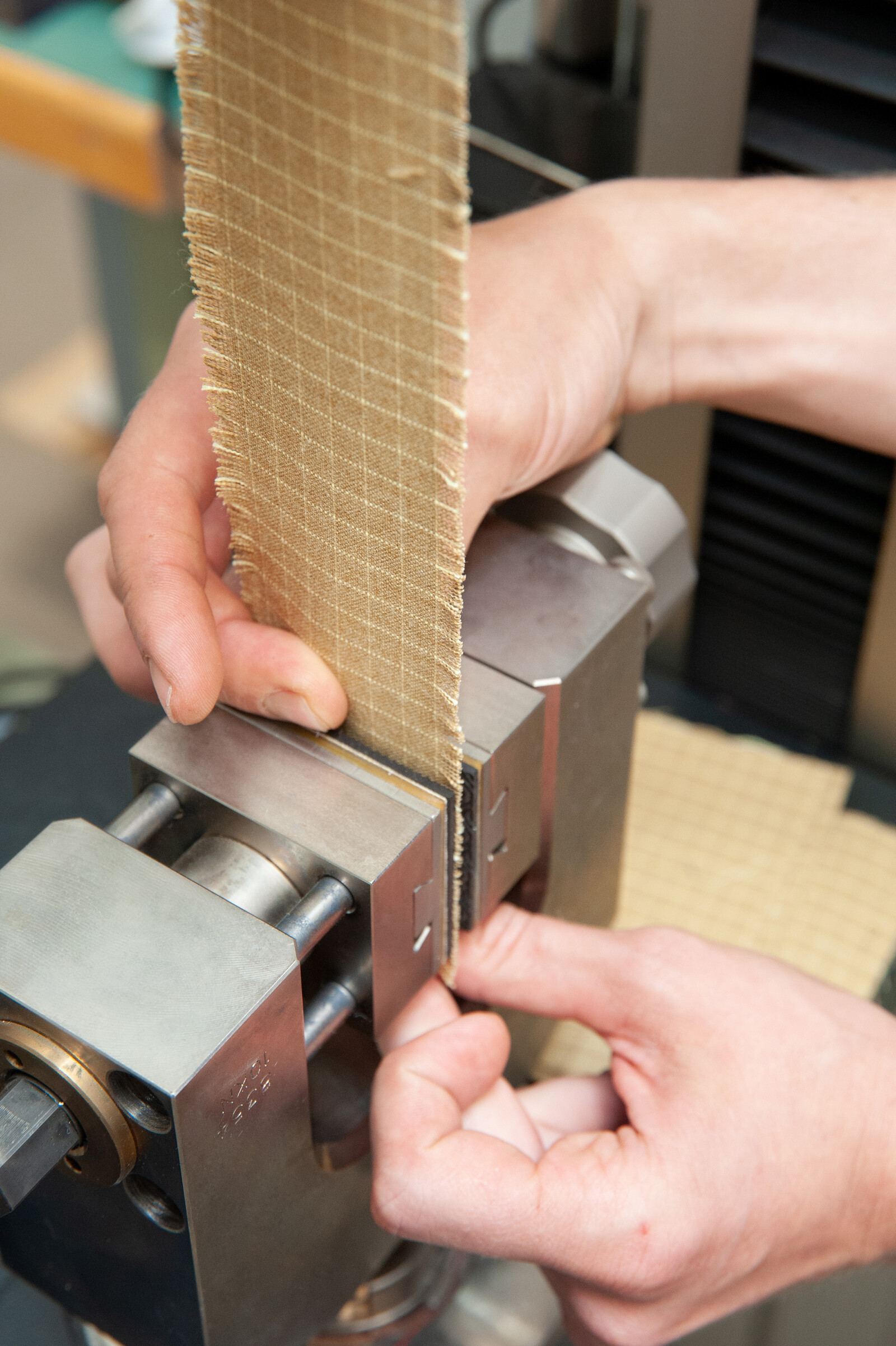Our extensive chemical-analytical and mechanical-physical tests enable you to meet the requirements placed on you and comply with national and international standards. We have decades of expertise at our disposal. As an accredited and independent testing laboratory with state-of-the-art testing equipment, we offer you comprehensive service and safety.
We conduct the tests mainly according to EN, ISO and EN/ISO standards, but we also offer a wide range of other services and tests for which we will be happy to provide you with a quotation on request.
Please find an overview of our accreditations and notifications here.
Chemical-analytical tests
What we test:
- Tests for harmful substances
- REACH compliance
- Screenings and testing against the Manufacturing Restricted Substances List (MRSL) and Restricted Substances List (RSL)
- GMO cotton tests
- Colour fastness tests
- UV protection
- Damage analysis
- Odour test
Mechanical-physical tests
What we test:
- Material analysis quantitative and qualitative (various methods)
- DNA analysis of animal fibres *)
- Limit viscosity of celluloses
- Fibre fineness/fibre length (various methods)
- Strength and elongation of fibres/fibre shrinkage
- Type of yarn (OE vs ring-spun yarn)
- linear density of yarns / twisted treads
- Strength/elongation of yarns / twisted treads
- Yarn purity/imperfections (Classimat II)
- Shrinkage yarns / twisted treads (various methods)
What we test:
- Material analysis quantitative and qualitative (various methods)
- DNA analysis of animal fibres *)
- Determination of characteristic features of fabrics:
- Determination of characteristic features of woven fabrics structures, weight per unit area, thickness, linear density (warp/weft), number of threads (warp/weft)
- Determination of characteristic features of knitted fabrics: structures, weight per unit area, thickness, linear density, number of courses, wales and stitch density
- Determination of characteristic features of nonwovens: weight per unit area, thickness
- Determination of the structures (woven fabrics) / (knitted fabrics)
- Determination of thickness (various methods)
- Determination of linear density in woven fabrics / in knitted fabrics
- Determination of the number of threads per unit length
- Determination of the number of courses, wales and stitch density of knitted fabrics
- Inorganic / organic fabric incrustation
- Assessing appearance-change of apparel and other textile end products after domestic washing and drying (Monsanto-Standard)
- Clothing Physiology – water vapour resistance (Ret-value) / thermal resistance (Rct-value) / water vapour permeability index
- Bursting properties of fabrics
- Resistance to damage by flexing – Method C "Knitter/Biege-Verfahren"
- Determination of blocking resistance (Rubber- or plastics-coated fabrics)
- Flex cracking test (artificial leather and similar sheet materials)
- downy feather proof/fleece proof/fibre proof (various methods)
- Tests for colour fastness (various methods see „Colour - Tests“)
- Determination of maximum force and elongation - strip method (dry/wet) (various methods)
- Determination of maximum force - grab method (dry/wet) (various methods)
- Limit viscosity of celluloses
- Determination of materials soluble in organic solvents / Determination of materials soluble in water
- Air-permeability
- Dimensional change after washing and drying
- Dimensional change after cleaning and finishing
- Microscopic examinations
- Seam tensile properties/slippage resistance of yarns at a ready-made seam / and various further methods
- oil repellency/water repellency "3M-Test."
- resistance to pilling and change of appearance of fabrics EN ISO 12945-2 and various further methods
- Velocity of soaking water of textile fabrics (a method by determining the rising height) DIN
- Abrasion resistance of fabrics „Martindale method” EN ISO 12947-2 and various further methods
- Determination of anions active surfactants / non-ionic surfactants
- Examination according to RIMS 1020
- silicate determination
- pH-value
- Solvent-soluble parts
- UV-protection
- UV-Protection-Factors UV-Standard 801
- Solar UV protective properties
- Water repellency of fabrics by the “Bundesmann rain-shower test.”
- Resistance to surface wetting (Spray test) / Water absorption of fabrics
- Tear force (various methods)
- Resistance to penetration by liquid chemicals
- Resistance to penetration by water (Hydrostatic pressure test)
- Elastic behaviour (various methods)
What we test:
- Assessing appearance-change of apparel and other textile end products after domestic washing and drying (Monsanto-Standard)
- Clothing design - assessment of the manufacturing quality
- Determination of dimensional - ready-made garments
- Seam tensile properties/slippage resistance of yarns at a ready-made seam (various methods)
- Assessment of the fitting
- Various failure analysis
What we test:
- Colorimetry (CIE tristimulus values)
- Colour difference
- Colour change / Staining - visual assessment with the grey scale
- Tests for colour fastness:
- Colour fastness to artificial light (various methods):
- Colour fastness to domestic and commercial laundering (various methods)
- Colour fastness to dry cleaning using perchloroethylene solvent
- Colour fastness to water (various methods) / Colour fastness to water (severe)
- Colour fastness to seawater
- Colour fastness to chlorinated water (swimming-pool water)
- Colour fastness to spotting - Water
- Colour fastness to hot water
- Colour fastness to perspiration (acidic & alkaline)
- Colour fastness to spotting
- Colour fastness to spotting - Alkali
- Colour fastness to potting
- Colour fastness to steaming
- Colour fastness to milling (various methods)
- Colour fastness to milling - Alkaline milling
- Colour fastness to acid-felting (severe)
- Colour fastness to acid-felting (mild)
- Colour fastness to bleaching (various methods):
- Colour fastness to mercerizing
- Colour fastness to organic solvents
- Colour fastness to cross-dyeing
- Colour fastness to hot pressing
- Colour fastness to rubbing (various methods):
- Assessment of the potential for phenolic yellowing of materials
- Retroreflective photometric performance (entrance angle of 5° / observation angle of 12’) EN ISO 20471 Pkt.7.3
- Washing process test (Ash determination / Limited viscosity / Tensile strength – wet / Degree of whiteness according to Ganz)
What we test:
- Horizontal Resistance and Vertical Resistance
- Electrostatic Charge (with two frictional partners)
- Protective clothing - Surface Resistivity, Type A
- Protective clothing - Vertical Resistance
- Protective clothing - Charge Decay *)
What we test:
- Limited flame spread
- Burning behaviour of fabrics for apparel
- Burning behaviour; Determination of ease of ignition; Flame spread properties vertically oriented specimens
- Contact heat transmission
- Burning behaviour by oxygen index *) (LOI-Index)
- Melting behaviour (Heat resistance of sewing thread)
- Determination of the arc rating*) of material (box Test) / of clothing (box test)
- Heat transmission on exposure to flame EN ISO 9195
- Thermal behaviour of materials and material assemblies when exposed to a source of radiant heat
- Heat resistance (convective heat)
What we test:
- Abrasion resistance of protective clothing material
- Clothing Physiology – water vapour resistance (Ret-value) / thermal resistance (Rct-value) / water vapour permeability index
- Limited flame spread
- Resistance to damage by flexing – Method C "Knitter/Biege-Verfahren"
- Surface Resistivity, Type A
- Vertical Resistance
- Charge Decay *)
- Contact heat transmission
- Air-permeability
- Resistance of materials to molten metal splash *)
- Chromatic coordinates and luminance factor - in new condition and after various pretreatments
- Melting behaviour (Heat resistance of sewing thread)
- Protective gloves – Abrasion resistance / Cut resistance *) / Tear resistance / Puncture resistance /
- Protective gloves – Burning behaviour
- Protective gloves – Measurement of flexibility "testing the dexterity."
- Protective gloves – Water penetration resistance of the entire glove
- Determination of arc protection class of material/clothing by using a constrained and directed arc *) (box test)
- Determination of the behaviour of materials on the impact of small splashes of molten metal *)
- Resistance to surface wetting (Spray test)
- Heat transmission on exposure to flame
- Thermal behaviour when exposed to a source of radiant heat (various methods)
- Resistance to penetration by liquid chemicals
- Resistance to penetration by liquids in the form of a light spray (fog test) *)
- Resistance to penetration by water (Hydrostatic pressure test)
- Heat resistance (convective heat)
What we test:
- Mechanical and physical properties
- Flammability
- Migration of certain elements
Emission testing
What we test:
- Emission tests according to ISO 16000 series and EN 16516
- Emission tests in accordance with the German AgBB scheme
- EMICODE® tests for flooring installations, adhesives and construction products
- Emission tests for textile floor coverings on the basis of GuT test criteria
- Emission tests on the basis of eco-label criteria (Austrian Eco-label, Blue Angel, nature plus)
- Emission tests in accordance with the French directive AFSSET/ANSES
- Odour tests of textile flooring on the basis of GuT testing criteria
- Odour tests in accordance with SNV 195 651
- Odour tests based on VDA 270
What we test:
- Indoor air analysis: formaldehyde, volatile organic compounds, gaseous substances like carbon dioxide, carbon monoxide, sulfur dioxide, ozone, nitric oxide, ...
- On-site odour test
- Fine dust measurements
- For our CLEANAIR certification of your indoor air quality, please click here
Further tests
What we test:
- Tests within the framework of the EU ECOLABEL for textiles and mattresses (the product group and criteria of the European ECOLABEL largely coincide with the Austrian ECOLABEL).
What we test:
- For an overview of our flooring technology tests, please go to flooring technology tests
What we test:
- For an overview of our interior design material tests, please go to interior design material tests
Assistance
What we test:
- Assistance in the event of damage
- Seminars / individual training
Tests marked with "*" are carried out by one of our accredited subcontractors if required.











